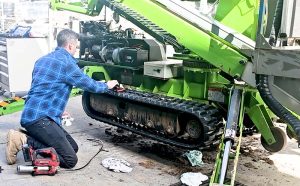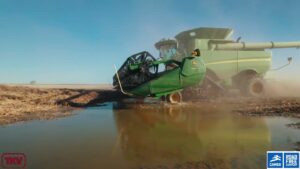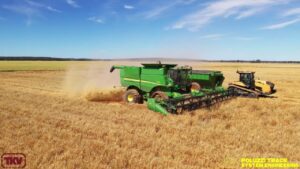At that time there was also a huge natural latex rubber shortage, so much so that mining tyres were almost impossible to obtain. Meanwhile, due to a shortage in supply, a large number of Chinese manufacturers were deciding that rubber tracks were the business to be in and during the mid-2000’s more than 30 new Chinese rubber track manufacturers appeared on the global scene.
THEN THE GFC HIT
Now bear in mind, none of these factories had any prior experience in the rubber track manufacturing process, they were simply copying what they thought established manufacturers were doing. Add to this the shortage of natural latex rubber, many of these suppliers were forced to experiment with synthetic and recycled rubber blends.
As the effects of the GFC spread around the world, the whole supply situation quickly reversed, rapidly changing from a severe under-supply to a massive over-supply on the global market. This over-supply situation has not improved, in fact it has worsened. Many new Chinese rubber track factories that were under-construction during the GFC period, are now up and operating, adding to the situation.
WHAT DOES THIS MEAN FOR YOU??
Profits are down: Due to cheap Chinese rubber tracks flooding the market, factories are struggling to turn a profit. Now what do companies do when they are losing money? You got it – cut costs!! That is exactly what we are seeing in Australia now. Let me show you where.
TRACK WEIGHT
We are seeing up to 30% reduction in the weight compared to quality reputable brands. This means thinner, skinnier, lighter weaker tracks with less wear-life.
For example – see pictures below of a standard Komatsu 3.5 tonne excavator rubber track.
The picture on the left is a standard Tufftrac rubber track: weight 170.1Kg
The picture on the right is cheap Chinese competitor’s rubber track: weight 116.9Kg – over 31% lighter!
So what impact does this have on rubber track quality? – Answer, lots!
TENSILE STRENGTH
We cut this competitor’s track open, the cables were 3mm diameter (absolute maximum – being generous!) – The Tufftrac standard is 3.6mm in this size rubber track. This means a 350% overall reduction in tensile strength in the new light-weight tracks compared to the Tufftrac standard. All fine and dandy when everything is going well, but what happens when you hit the tough job?
The below two pictures show the difference in carcass thickness – Tufftrac on left, cheapy on right. You can see the difference for yourself!
WEAR-LIFE
The land/sea ratio is the amount of tread compared to the amount of exposed track carcass. You can visibly see the difference – approximately 50% less on the cheap tracks. And this doesn’t even factor in the lower tread lug height visible above.
Do you think this is going to impact the amount of life you are going to get from your cheap rubber tracks? You bet it is!
The other factor affecting wear-life is the quality of the rubber compound itself. You can see the shiny black appearance of the track on the right, compared with the dull grey of the Tufftrac on the left. This shiny black rubber is typical of a synthetic plastic rubber compound. Yes it’s cheaper, but it is more brittle, less flexible, less dense and less abrasion resistant.
RUBBER TRACK WARRANTY – ARE THEY ALL EQUAL??
This is an interesting thing, many of these cheap track suppliers are offering extended warranties, even longer than reputable brands. For example even Bridgestone only offer 12 months!
HOW DO THEY DO IT??
Simple, remember warranty covers manufacturing faults, not wear and tear. You can’t claim warranty if your tracks simply wore out faster than expected. They can put whatever they want on their warranty terms and conditions, but who says that it is going to be honored.
WHAT ELSE??
Other issues we have commonly seen and heard of with these cheap rubber tracks include;
De-tracking. The lighter weight and lower strength commonly leads to track flex or snaking which causes the tracks to come off when under tension.
Bending core bars/drive lugs. Once again due to less internal steel, bending core bars is a common occurrence. Not exactly disastrous, but certainly ugly.
Lost core bars. This is typically symptomatic of poor manufacturing processes and lack of adequate quality control. Core bars need to be thoroughly degreased and acid etched to ensure good bonding to the rubber. Any residual oil, grease, moisture or contaminants result in the core bars coming out.
SO – DO YOU OR DON’T YOU RISK IT??
That question is ultimately up to you. All I can do is present the information and evidence. This will at least enable you to make an informed decision. Either way, if you have any questions or concerns, feel free to call and discuss. There is a number of reputable track suppliers out there on the market, others………..well…………you choose but be careful!
Ash Collins


